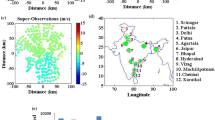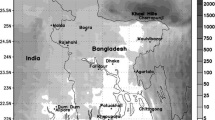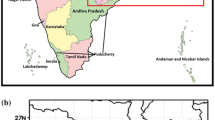Abstract
With the modernization of the India Meteorological Department, the observational network of the country, both in situ and remote sensing, is enhanced. The Doppler Weather Radar (DWR) network is improved, and the National Centre for Medium Range Weather Forecasting is acquiring radar data from 20 stations all over the country. The maximum utilization of DWR observations in the numerical models remains a challenging task. This study represents the first assessment of assimilation of radial wind observations from all 20 DWR stations, utilizing the resources of weather research and a forecasting model with a community grid-point statistical interpolation system. DWR observations are an important data source for mesoscale and microscale weather analysis and forecasting because of their high temporal and spatial resolution. However, the representation of DWR radial wind and reflectivity in a desired format seems to be crucial in the modeling approach. A series of experiments are conducted to evaluate the sensitivity of the analysis to the velocity azimuth display quality control (VADQC) and without VADQC (VARQC) to understand the effect of QC on analysis. The statistical analysis of assimilation of DWR radial wind suggests that a gate distance of 250 m or its multiple is imperative for the setup of the DWR. Additionally, the density of the super-observation is amplified in the VARQC approach. The analysis procedure is implemented for the recent severe cyclone Phethai (December 2018) over the Bay of Bengal, and a few preliminary results are discussed.












Similar content being viewed by others
References
Abhilash, S., Das, S., Kalsi, S. R., Das Gupta, M., Mohankumar, K., George, J. P., et al. (2007). Impact of Doppler radar wind in simulating the intensity and propagation of rainbands associated with mesoscale convective complexes using MM5-3DVAR system. Pure and Applied Geophysics, 164, 1491–1509.
Aksoy, A., Dowell, D. C., & Snyder, C. (2009). A multicase comparative assessment of the ensemble Kalman filter for assimilation of radar observations. Part I: Stormscale analyses. Monthly Weather Review, 137, 1805–1824. https://doi.org/10.1175/2008MWR2691.1.
Aksoy, A., Dowell, D. C., & Snyder, C. (2010). A multicase comparative assessment of the ensemble Kalman filter for assimilation of radar observations. Part II: Short range ensemble forecasts. Monthly Weather Review, 138, 1273–1292. https://doi.org/10.1175/2009MWR3086.1.
Alpert, J. C., & Kumar, V. K. (2007). Radial wind super-obs from the WSR-88D radars in the NCEP operational assimilation system. Mon. Wea. Rev., 135, 1090–1109.
Bouttier, F., & Courtier, P. (1999). Data assimilation concepts and methods. Meteorological training course lecture series. Reading: ECMWF.
Caya, A., Sun, J., & Snyder, C. (2005). A comparison between the 4DVAR and the ensemble Kalman filter techniques for radar data assimilation. Monthly Weather Review, 133, 3081–3094. https://doi.org/10.1175/MWR3021.1.
Collins, W. G. (2001). The quality control of velocity azimuth display (VAD) winds at the National Centers for Environmental Prediction. Preprints, 11th Symp. on Meteorological Observations and Instrumentation, Albuquerque, NM, Amer. Meteor. Soc., CD-ROM, 9.2.
Dowell, D. C., & Wicker, L. J. (2009). Additive noise for storm-scale ensemble data assimilation. Journal of Atmospheric and Oceanic Technology, 26, 911–927. https://doi.org/10.1175/2008JTECHA1156.1.
Dowell, D. C., Wicker, L. J., & Stensrud, D. J. (2004). High resolution analyses of the 8 May 2003 Oklahoma City storm. Part II: EnKF data assimilation and forecast experiments. In Preprints, 22nd conference on Severe Local Storms, Hyannis, MA, American Meteor Society, 12.5. https://ams.confex.com/ams/pdfpapers/81393.pdf.
Droegmeier, K. K. (1997). The numerical prediction of thunderstorms: Challenges, potential benefit, and results from real-time operational test. WMO Bulletin, 46, 324–336.
Gao, J., & Xue, M. (2008). An efficient dual-resolution approach for ensemble data assimilation and tests with simulated Doppler radar data. Monthly Weather Review, 136, 945–963.
Gao, J., Xue, M., Brewster, K., & Droegemeier, K. K. (2004). A three-dimensional variational data analysis method with recursive filter for Doppler radars. Journal of Atmospheric and Oceanic Technology, 21, 457–469.
Ge, G., Gao, J., & Xue, M. (2012). Diagnostic pressure equation as a weak constraint in a storm-scale three-dimensional variational radar data assimilation system. Journal of Atmospheric and Oceanic Technology, 29, 1075–1092.
Holleman, I., Benschop, H. & Van Der Meulen, J. (2005). upper air wind measurements by weather radar. In WMO technical conference on meteorological and environmental instruments and methods of observation. https://www.wmo.int/pages/prog/www/IMOP/publications/IOM-82-TECO_2005/Papers/2(05)_Netherlands_5_Holleman.pdf.
Hu, M., Xue, M., & Brewster, K. (2006). 3DVAR and cloud analysis with WSR-88D Level-II data for the prediction of the Fort Worth, Texas, Tornadic Thunderstorms. Part I: Cloud analysis and its impact. Monthly Weather Review, 134, 675–698. https://doi.org/10.1175/MWR3092.1.
Johnson, A., Wang, X., Carley, J. R., Wicker, L. J., & Karstens, C. (2015). A comparison of multiscale GSI-based EnKF and 3DVar data assimilation using radar and conventional observations for midlatitude convective-scale precipitation forecasts. Monthly Weather Review, 143, 3087–3108. https://doi.org/10.1175/MWR-D-14-00345.1.
Jung, Y., Zhang, G., & Xue, M. (2008). Assimilation of simulated polarimetric radar data for a convective storm using the ensemble Kalman filter. Part I: Observation operators for reflectivity and polarimetric variables. Monthly Weather Review, 136, 2228–2245. https://doi.org/10.1175/2007MWR2083.1.
Kleist, D. T., Parrish, D. F., Derber, J. C., Treadon, R., Wu, W.-S., & Lord, S. (2009). Introduction of the GSI into the NCEP global data assimilation system. Weather Forecasting, 24, 1691–1705. https://doi.org/10.1175/2009WAF2222201.1.
Lippi, D. (2016). Assimilation of radar radial velocity with GSI-based hybrid 3DEnVar system for improved precipitation forecasts. MS Thesis, University of Maryland, pp 1–36.
Liu, S., Xue, M., Gao, J. & Parrish, D. (2005). Analysis and impact of super-obbed Doppler radial velocity in the NCEP Grid-point Statistical Interpolation (GSI) analysis system. In Preprints, 21st conference on weather analysis and forecasting/17th conf. on numerical weather prediction. Washington, DC, Amer. Meteor. Soc., 13A.4. https://ams.confex.com/ams/WAFNWP34BC/techprogram/paper_94230.html.
Lu, H., & Xu, Q. (2009). Trade-offs between observation accuracy and resolutions in configuring phased-array radar velocity scans for ensemble-based storm-scale data assimilation. Journal of Applied Meteorology and Climatology, 48, 1230–1244. https://doi.org/10.1175/2008JAMC2009.1.
Osuri, K. K., Mohanty, U. C., Routray, A., & Niyogi, D. (2015). Improved prediction of Bay of Bengal tropical cyclones through assimilation of Doppler weather radar observations. Monthly Weather Review, 143(11), 4533–4560.
Prasad, S. K., Mohanty, U. C., Routray, A., Osuri, K. K., Ramakrishna, S. S. V. S., & Niyogi, D. (2014). Impact of Doppler weather radar data on thunderstorm simulation during STORM pilot phase—2009. Natural Hazards, 74, 1403–1427.
Prasad, V. S., Johny, C. J., & Singh Sodhi, J. (2016). Impact of 3D Var GSI-ENKF hybrid data assimilation system. Journal of Earth System Science, 125, 1509–1521. https://doi.org/10.1007/s12040-016-0761-3.
Purser, R. J., Parrish, D., & Masutani, M. (2000). Meteorological observational data compression; an alternative to conventional “super-obbing”. NCEP Office Note 430, 13 pp.
Purser, R. J., Wu, W.-S., Parrish, D. F., & Roberts, N. M. (2003a). Numerical aspects of the application of recursive filters to variational statistical analysis. Part I: Spatially homogeneous and isotropic gaussian covariances. Monthly Weather Review, 131, 1524–1535.
Purser, R. J., Wu, W.-S., Parrish, D. F., & Roberts, N. M. (2003b). Numerical aspects of the application of recursive filters to variational statistical analysis. Part II: Spatially inhomogeneous and anisotropic general covariances. Monthly Weather Review, 131, 1536–1548.
Routray, A., Mohanty, U. C., Osuri, K. K., & Kiran Prasad, S. (2013). Improvement of monsoon depressions forecast with assimilation of Indian DWR data using WRF-3DVAR analysis system. Pure and Applied Geophysics, 170, 2329–2350.
Routray, A., Mohanty, U. C., Rizvi, S. R. H., Niyogi, D., Osuri, K. K., & Pradhan, D. (2010). Impact of Doppler weather radar data on numerical forecast of Indian monsoon depressions. Quarterly Journal Royal Meteorological Society, 136, 1836–1850.
Snyder, C., & Zhang, F. (2003). Assimilation of simulated Doppler radar observations with an ensemble Kalman filter. Monthly Weather Review, 131, 1663–1677.
Stensrud, D. J., et al. (2013). Progress and challenges with warn-on-forecast. Atmospheric Research, 123, 2–16.
Stensrud, D. J., & Gao, J. (2010). Importance of horizontally inhomogeneous environmental initial conditions to ensemble storm-scale radar data assimilation and very short-range forecasts. Monthly Weather Review, 138, 1250–1272. https://doi.org/10.1175/2009MWR3027.1.
Sun, J. (2005). Convective-scale assimilation of radar data: Progress and challenges. Quarterly Journal of the Royal Meteorological Society, 131, 3439–3463.
Tong, M., & Xue, M. (2005). Ensemble Kalman filter assimilation of Doppler radar data with a compressible nonhydrostatic model: OSS experiments. Monthly Weather Review, 133, 1789–1807.
Wu, W.-S., Purser, R. J., & Parrish, D. F. (2002). Three-dimensional variational analysis with spatially inhomogeneous covariances. Monthly Weather Review, 130, 2905–2916. https://doi.org/10.1175/1520-0493(2002)130<2905:TDVAWS>2.0.CO;2.
Xiao, Q., Kuo, Y.-H., Sun, J., Lee, W.-C., Lim, E., Guo, Y.-R., et al. (2005). Assimilation of Doppler radar observations with a regional 3DVAR system: Impact of Doppler velocities on forecasts of a heavy rainfall case. Journal of Applied Meteorology, 44, 768–788. https://doi.org/10.1175/JAM2248.1.
Xue, Q., Lu, H., Gao, S., Xue, M., & Tong, M. (2008). Time-expanded sampling for ensemble Kalman filter: Assimilation experiments with simulated radar observations. Monthly Weather Review, 136, 2651–2667.
Yussouf, N., & Stensrud, D. J. (2010). Impact of phased-array radar observations over a short assimilation period: Observing system simulation experiments using an ensemble Kalman filter. Monthly Weather Review, 138, 517–538. https://doi.org/10.1175/2009MWR2925.1.
Acknowledgements
The authors owe special thanks to Dr. E. N. Rajagopal, Head, NCMRWF, MoES, for providing support and encouragement to carry out this highly needed research work. The authors are thankful to Donald Lippi, University of Maryland, for his suggestion and help in carrying out this study. The authors thank the India Meteorological Department (IMD) for providing the GFS forecast for the study period.
Author information
Authors and Affiliations
Corresponding author
Additional information
Publisher's Note
Springer Nature remains neutral with regard to jurisdictional claims in published maps and institutional affiliations.
Rights and permissions
About this article
Cite this article
Pattanayak, S., Prasad, V.S. Assimilation of Radial Winds Over India Using a Community GSI Analysis System. Pure Appl. Geophys. 177, 5081–5099 (2020). https://doi.org/10.1007/s00024-020-02527-8
Received:
Revised:
Accepted:
Published:
Issue Date:
DOI: https://doi.org/10.1007/s00024-020-02527-8




